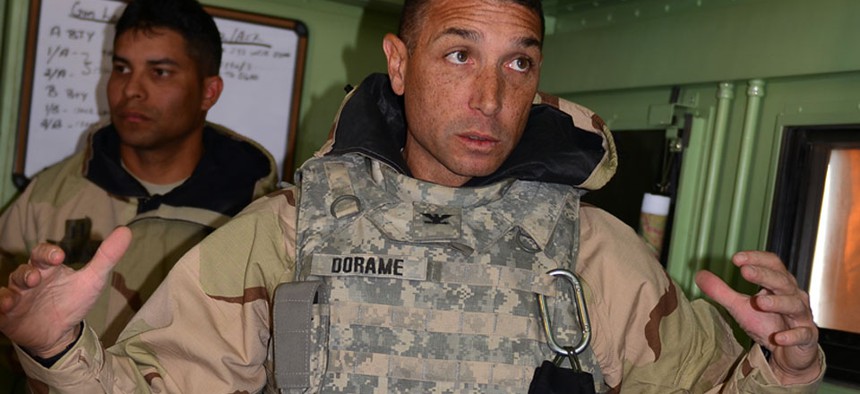Cloud-Based Network Defense Frustrates Army Exercise Commander

Col. Thomas Dorame spoke to Nextgov in his tactical command post for the Army Network Integration Evaluation, Ft. Bliss. Anne Gammell/United States Army
Brigade chief says he needs local control over the ‘cyber fight’ affecting his computer systems.
This story has been updated with new information from DISA and edited for clarity. The headline was also changed.
Ft. Bliss, Texas – Col. Thomas Dorame, commander of the 2nd Brigade, 1st Armored Division, knows enemy forces have penetrated his computer systems here during a semi-annual exercise to test Army battlefield networks, but he has little immediate visibility into the attacks due to a policy change that shifted network defense to a remote location.
Dorame, speaking in his mobile tactical command post, said he was frustrated that he had little local control of the “cyber fight” affecting his tactical networks, which connect his 3,700 soldiers engaged in the exercise.
Lt. Col. Lawrence Karl, officer in charge of the Network Operations Center for the latest exercise in the Network Integration Evaluation series, said defense of the brigade’s networks during the NIE is handled by a host-based security system remotely located at Fort Gordon, Ga. The system consists of a suite of software products that can automatically detect and prevent intrusions.
It wasn't clear why the Army shifted network defenses to Fort Gordon when during previous exercises they were handled locally. The Defense Information Systems Agency does not require tactical networks to be defended remotely, officials there said. DISA supports both enterprise hosting at its core data centers as well as customers who require local defense, said Andrew Harris, enclave defense advisor in the mission assurance program executive office.
“For DISA's customers wishing to go down the local implementation route, the customer receives documentation, training resources, helpdesk, architectural and engineering support to help plan and integrate the service in their existing networks, and even certification packages that are accredited by the DoD Security Accreditation Working Group, enabling DoD reciprocity,” Harris said. “These services help the customer take a tool or service and get it fielded and operational in the shortest amount of time, while still giving them full control over that infrastructure.”
At the NIE last year, Dorame said he had these tools available within his command, but this year his staff needed to fill out a “trouble ticket” for action by the remote system, a process that slows down network defense. “If I have a flat tire, a spare and a jack, why not change the tire myself rather than calling and waiting for AAA to show up?” Dorame wondered.
Network defense is critical, as Dorame knows from his experience last year at the NIE, when the opposing force penetrated his battlefield network so thoroughly that his only solution was to sever all satellite connections to the outside world and then use a terrestrial system to communicate with his maneuver units.
Mike McCarthy, director of simulation operations and program manager for the Army Brigade Modernization Command, said that at the last NIE, the opposing force managed to not only penetrate the network, but then went on to destroy and deface Web pages; this year they were told not to engage in such behavior.
The key purpose of the semi-annual NIEs is to apply lessons learned here to Armywide policies and procedures. Dorame said he “strongly advocates” battlefield commanders have the ability to defend their networks locally.
The NIE started Oct. 23 and ends Nov. 15.
Join us at Nextgov Prime in Washington Nov. 20-21 to discuss the biggest challenges and opportunities facing federal IT leaders. Registration is free for federal employees.






